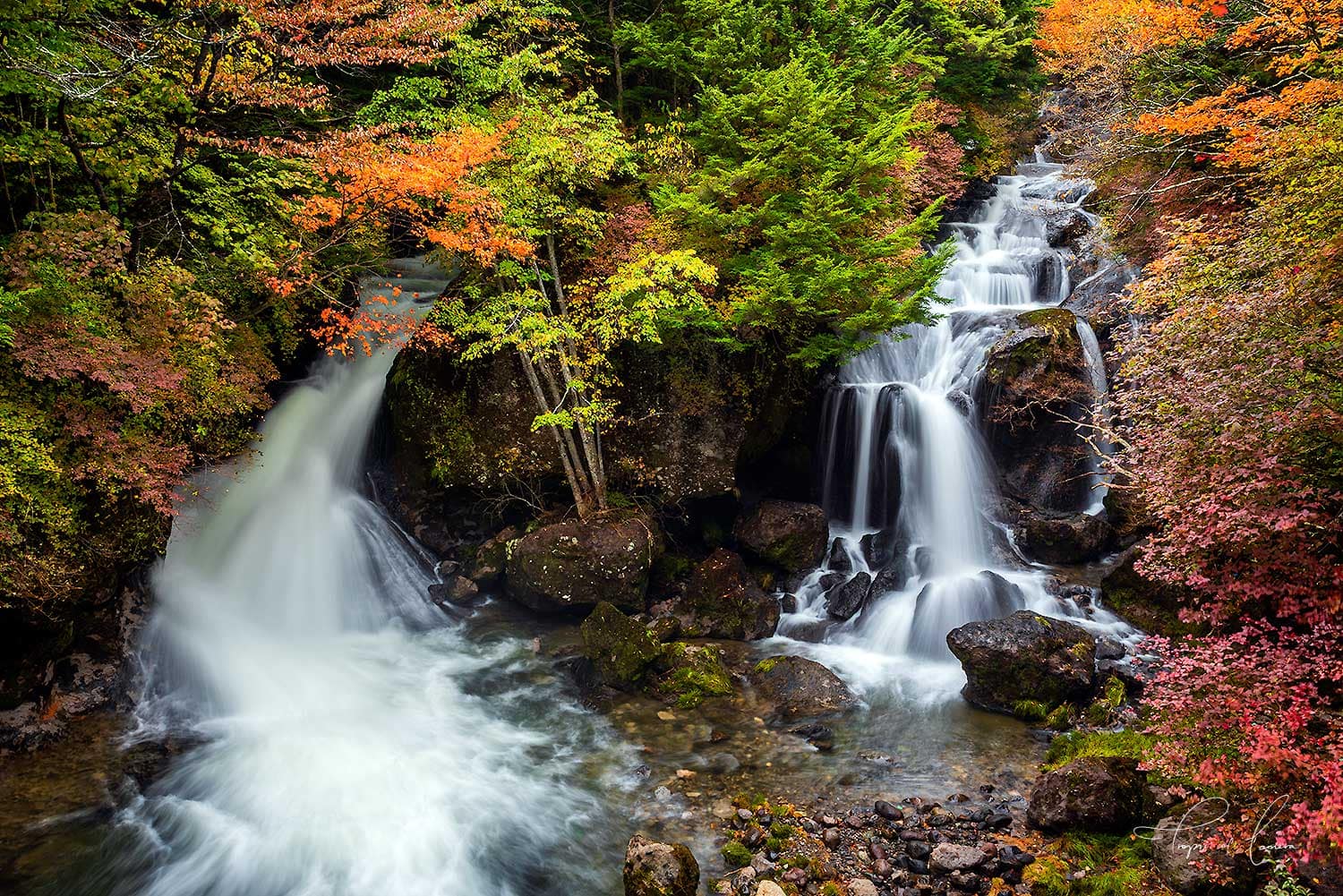Only two hours from Tokyo, Nikko National Park is a spectacular landscape photography location. It’s particularly scenic in autumn, when the leaves change colours in dramatic fashion. Of course, this is when everyone else comes to visit, but there’s a reason for that.
While many people recommend doing a day trip to Nikko, there’s a lot you’ll miss out on without delving further into the national park. With so much to do in Nikko National Park, you could easily spend 3 days exploring this natural area, doing hikes and hitting up Edo Wonderland (I’m a sucker for kitschy theme parks).
I had one and a bit days, so I had to make it count.
Shinkyo Bridge
I arrived in the late afternoon after a twelve-hour flight from Australia, with an extra couple of hours on the train. I was exhausted, but I knew I didn’t have much time to go shooting, so I headed out for a walk to Nikko’s iconic Shinkyo Bridge. ⠀
I learned quickly that things were not as close as they appeared on the map, and my Vans were not cut out for long hikes.
Shinyoko Bridge marks the start of the UNESCO World Heritage temples. While it’s a popular shot for photographers to the area, I loved how these long exposures turned out with that misty, moody river under the bridge.
Exploring Nikko National Park
I woke the next day to a world surrounded in mist and fog. Regardless, I hopped on the bus to explore the national park. I’d planned to go up the cable car for the view of the mountains and waterfalls, but looking out the bus window, it sure wasn’t the weather for it. I could barely see the trees past the roadway, let alone a mountainous vista. Don’t get me wrong, I enjoy shooting in fog – you get some amazing images – but this was next level.
Kegon Falls
First stop: Kegon Falls. I went to look at the waterfall. And saw a cascading mist of… white. But I loved the eerie vibes the fog was giving off, so I took some shots of the carpark and buildings.
I decided to take the bus to the end of the line. Why not? I’d paid for an all-day bus pass. Maybe the weather would clear up once I got to Yunoko Lake.
Lake Yunoko
Good decision.
By the time I’d stopped at every single stop (and caught glimpses of waterfalls between orange leaves), the fog had cleared up to a mildly overcast day. The turquoise water of Lake Yunoko glimmered in patchy sunshine, against the backdrop of the mountains.
At Lake Yunoko you can walk to a foot onsen, at the back of the streets among the hotel complexes. Everyone should have their own personal foot onsen. It was a wonderful way to soak the feet after lots of walking for the cost of a small donation.
I stopped for lunch at a café overlooking the lake, enjoying a simple meal of pork on rice with miso soup. The view was worth it; I watched the sun flicker in and out of the lake, over the rows of boats.
From there, the fog had cleared up. A wooden walkway surrounds the lake, so I hiked for half-an-hour down to the waterfall I’d glimpsed through the trees. It was a peaceful hike, autumn leaves surrounding the lake; I stopped several times to experiment with my neutral density filter and take long exposures during the day.
Yutaki Falls
The walkways were crowded with tourists, so I hiked a little further down the trail to get some shots of the waterfall without people banging my tripod or shaking the ground.
I stopped for a mackerel on a stick, getting a quick environmental portrait of the food vendor. I loved the way the coals lit up the area, but I had to bump my ISO up to around 800 as it was dark.
Kegon Falls
It was getting late, so I had time to stop at one more waterfall. I’d wanted to see Kegon Falls, known for its dual waterfall. I got off the bus at the top and walked down (much better than walking up), following the trail and taking a few long exposures as I went. I loved how this one turned out, glimpsed through the trees.
Lake Chuzenji
From there, I thought I’d mosey on down to Lake Chuzenji, but the weather was closing in. As I walked down, specks of rain flicked across my hair. I rolled off a couple of shots, but the fog and clouds had returned. Time to get on the bus and head back to Nikko.
Despite the weather, I loved visiting Nikko National Park. If I’d had more time, I would have explored the Kanmangafuchi Abyss, hiked Mt Nantai and the Senjogahara Plateau. It’s just a good excuse to go back.
How to get around Nikko National Park
Nikko National Park is well serviced by Tobu Bus and they have maps and information in English available online. You can buy a hop-on hop-off bus pass for Nikko National Park at the train station and tourist information centres. They offer good value for money, saving up to 1500 yen on long trips. The bus passes cover different areas, so be aware of how far you wish to travel, as it will be more expensive to go all the way out to Lake Yunoko vs Chuzenji Onsen.
Also be aware, that when a Japanese bus ticket says “valid for x days” it doesn’t mean it’s a multi-day ticket. It’s only valid for the date on the ticket.
Finally, note the last bus time on the schedule and plan accordingly – you don’t want to get stuck out in the mountains!








Absolutely stunning! Love seeing your natural side
https://lisabnatural.com/sa/